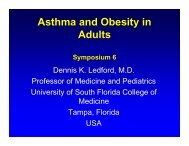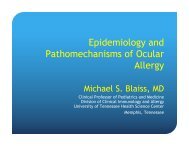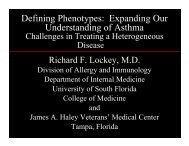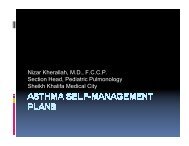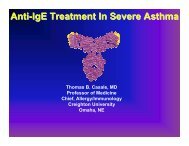Dubai Final-v20.indd - World Allergy Organization
Dubai Final-v20.indd - World Allergy Organization
Dubai Final-v20.indd - World Allergy Organization
Create successful ePaper yourself
Turn your PDF publications into a flip-book with our unique Google optimized e-Paper software.
ABstrACts<br />
ABstrACts<br />
patients with acquired cold urticaria (ACU), unresponsive to standard treatment with high doses of antihistamines, montelukast and/<br />
or corticosteroids.<br />
methods: Four patients with ACU (three males, one female, median age = 34 years) with a critical stimulation time threshold (Cstt)<br />
at 3 minutes. three out of the four cold urticaria patients had a history of systemic anaphylactic reactions after exposure to cold<br />
environment and episodes of urticaria-angioedema several times a week during the winter, spring and autumn.<br />
results: treatment with omalizumamb, resolved symptoms in three out four patients with cold urticaria (time to clinical response<br />
1.5 months). Only the patient with the lowest total igE (4.1 iU/ml) had a mild response to treatment, although the Csst became<br />
negative on the second month of treatment. Conclusion:treatment with omalizumab can be beneficial in selected patients with cold<br />
urticaria refractory to standard treatment with antihistamines and /or corticosteroids. Patients with low levels of total igE may not<br />
respond adequately to treatment with Omalizumab.<br />
2304<br />
THE aCTiVE Form oF D ViTamin, CalCiTriol 1,25(oH)2D3 anD naTUral PPrgamma agoniST, -3 PolYUnSaTUraTED<br />
FaTTY aCiDS (PUFaS) migHT SErVE aS a nEgaTiVE FEEDBaCK looP To PrEVEnT EXCESSiVE inFlammaTion in PaTiEnTS<br />
WiTH SEVErE aToPiC DErmaTiTiS<br />
Zaharov, t. 1 , Chaynava, A. 2 , Kamenov, B. A. 3 and Kamenov, s. 4<br />
1 2 3 Pediatrics, regional Hospital næstved, naestvad, Denmark. Pediatrics, regional Hospital næstved, naestved, Denmark. Pediatric<br />
Clinic, Clinical Centre of nis, nis, serbia and montenegro. 4Pediatric, Helth Centre of nis, nis, serbia and montenegro.<br />
the function of vitamin D is promoting cell differentiation, cell maturation and inhibiting (uncontrolled) cell proliferation. VDr is<br />
expressed by almost all immune cells, including activated CD4+ and CD8+ t cells, B cells, neutrophils, and APCs . 1,25(OH)2D<br />
inhibits th-1 type immune function in adult (memory) cells, induces t regulatory cells, and enhances phagocytosis by white blood<br />
cells. Vitamin D inhibits the activation of t cells, and promotes tolerance in dendritic cells.39,40 VDr has also been implicated in<br />
toll-like-receptor (tlr) signaling and regulation of the innate immune response in macrophages. Current evidence indicates that<br />
PUFAs can prevent the development of inflammatory diseases by affecting different steps of the immune response.<br />
Case reports:<br />
14 months old girl, known with severe atopic dermatitis, debuted at first days of life, had relapsed several staphylococci cutaneous<br />
infections, vasculitis like syndrome without positive verification of PCr/Antibody of Herpes family virus and was many times in<br />
treatment with per os and i.v. antibiotics. in the first 9 months of age exclusive breastfeedings, but due to event stimulation after<br />
mothers diet, stopped. started with diet restriction, only specific milk formula neocat, PUFAs , calcitriol and probiotics(lgg).<br />
results: 1) before immunomodulatory therapy, only with skin care and topical Cs, intermittent topical calcineurin inhibitors and<br />
pruritis control: very high igE over 5000, over 100 for cows milk, eggs and cross reaction almost of all, one that was normal was<br />
fish and shrimps igE, high Eo counts, 1.68, thrombocytosis and neu-peni. Calcitrol 204, normal levels of immunoglobulin’s, C1q<br />
concentration 77%, slightly below ref. intervals, reduced activity of complement via the mBl pathway and decreased concentration<br />
of B cells. 2) After: normalization of le and tr counts, especially nice response in Eo are decreasing to 0.53, reduction in igE level<br />
to 2500.EDtA blood for t, B and nK cell: normal proportions and concentrations of t and B / nK lymphocytes, nice response of<br />
virgin tcell, normal exposure of adhesions molecules, normal t cell proliferation by polyclonal stimulation, normal value of somatic<br />
mutation. there are no signs of maternal engraftment on the CD4/CD8 separated cells. there is not sign of stAt3 deficiency.<br />
Clinical benefit, much better without signs of acute infections and severe itching, almost normal skin without lesions, normal<br />
growth.<br />
2305<br />
mETHoTrEXaTE For UrTiCarial VaSCUliTiS anD angioEDEma WiTH CrYogloBUlinEmia<br />
Butt, A. , Alkhalil, m. , ledford, D. and lockey, r. F.<br />
Division of <strong>Allergy</strong> & immunology, University of south Florida and James A. Haley Veterans’ Hospital, tampa, Fl.<br />
Background: Cryoglobulinemia (Cg) is associated with a leukocytoclastic vasculitis primarily affecting the kidneys, skin and<br />
peripheral nerves. Urticaria, but not usually angioedema, is a potential presentation for Cg. Cryoglobulins are usually associated<br />
with infectious, autoimmune and lymphoproliferative disorders; therefore, treatment options are varied. We report a patient with<br />
corticosteroid (Cs)-dependent urticaria and angioedema (U/AE) who was able to discontinue Cs therapy following weekly oral<br />
methotrexate (mtX).<br />
results: 57-year- old Caucasian male presented with a seven month history of recurring symptoms of generalized urticaria and<br />
facial angioedema. the symmetrical rash initially developed after a dental procedure requiring penicillin therapy. the findings<br />
were attributed to penicillin, but persistence of the rash prompted a skin biopsy which demonstrated a leukocytoclastic vasculitis.<br />
Prednisone, 10 mg twice daily, resulted in minimal improvement of the rash, but arthritic pain in the hands and knees developed.<br />
An immunologic and rheumatologic evaluation showed type 3 mixed Cg without monoclonal protein, 2+ urinary protein, decreased<br />
www.worldallergy.org 134<br />
FinAl PrOgrAm





